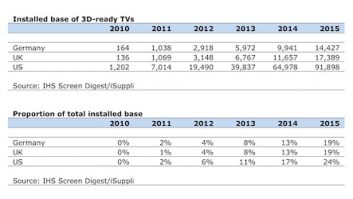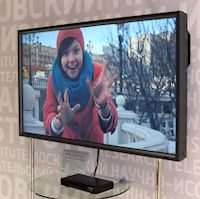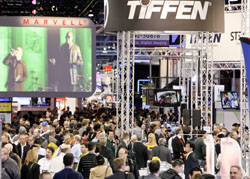
CES report: Autostereoscopic displays point the way forward for the 3DTV industry but the technology is far from mature, writes Adrian Pennington.
There are several glasses-free 3DTV displays at CES, among them a commercial launch of Stream TV’s Ultra-D technology in Q2. The company, which makes software and firmware for autostereoscopic displays, says it is has already signed deals with a consumer electronics brand to embed the Ultra-D technology in its sets.
Toshiba is exhibiting its glasses-free 3DTV, which has launched in Japan and will shortly launch in the US – priced at a staggering $11,500.
On display are three 55-inch 4K panels of the REGZA 55X3 TV which, were they to display 2D HD content would do so at a 3840×2160 pixel resolution using QFHD – or Quad Full High Definition.
With the 3D function switched on that resolution is split into 9 frames – or 9 views – of 720p HD. It gives a reasonably good experience and wide field of vision, particularly when the automatic face tracking system is turned on so that should you move the screen view automatically adjusts to your new position. However, the experience is more problematic when there is more of one person watching. Since the tracking system only detects one face, it means that should that person move, everyone else has to shift position also. Like Stream TV’s technology it uses a lenticular sheet placed across the panel to distribute light into multiple views.
“To generate more views and therefore a higher resolution we would require a panel beyond 4K which isn’t practical at the moment,” Toshiba’s demo spokesman said.
No pricing or product names were provided and neither were they at Sony, which is also showing a glasses-free demonstration-only LCD TV in 24 and 46 inches – the latter a 4K panel. Sony is also keeping the number of views its technology can deliver under wraps.
Meanwhile on the 3D@Home booth is a small company claiming to trump every other rival autostereo screen. New York’s Dimension Technologies uses a patented technology called Time Multiplexed Backlight, which inserts a single active substrate between the LCD and its backlighter.
“When turned on it allows the display to show real 3D images by creating light lines. These light lines are placed behind a conventional LCD panel,” said company CEO Arnold Lagergen. “The ability to convert instantly from 3D to 2D display makes our displays unique. No other 3D display converts to full resolution 2D.”
Lagergen claimed interest from Samsung and Toshiba. “They are all stopping by – this is the future,” he said.







